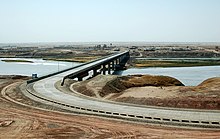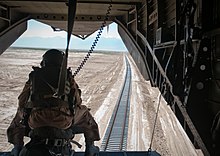Transportation in Afghanistan is limited and still in the developing stages, which serves a population of about 29 million people. Landlocked Afghanistan has no seaports but the Amu Darya (Oxus) River, which forms part of the nation's border with Turkmenistan, Uzbekistan, and Tajikistan, does have barge traffic. Rebuilding of airports, roads, and a railway line has led to rapid economic boost in the country in the last five years. Much of Afghanistan's road network was built during the 1960s. New national highways, roads, and bridges have been rebuilt in recent years to help increase travel as well as trade with neighboring countries. The nation has about 53 airports, which have been built within the last 50 years.
Highways
History
Most road building occurred in the 1960s, funded by the United States and the Soviet Union. The Soviets built a road and tunnel through the Salang pass in 1964, connecting northern and southern Afghanistan. A highway connecting the principal cities of Herat, Kandahar, Ghazni, and Kabul with links to highways in neighboring Pakistan formed the primary road system.
The network includes 12,350 kilometers of paved roads and 29,800 kilometers of unpaved roads, for an approximate total road system of 42,150 kilometers as of 2006.
Major highways
Highway 1 (Afghanistan)
The highway system is currently going through a total reconstruction phase. Most of the regional roads are also being repaired or improved. For the last 30 years, the poor state of the Afghan transportation and communication networks have further fragmented and hampered the struggling economy.
Since the fall of the Taliban many roads have been rebuilt with foreign assistance including:
Kabul-Kandahar Highway
Kabul-Jalalabad-Torkham Highway
Kabul-Gardez Highway
Kabul-Mazar Highway
Kandahar-Boldak Highway
Kandahar-Herat Highway
Herat-Islam Qala Highway
Herat-Mazar Highway
Route Trident (Lashkar Gah to Gereshk)
A road bridge linking Tajikistan and Afghanistan which cost $37 million was inaugurated in 2007. The bridge, nearly 700 metres long and 11 metres across, straddles the Panj river which forms a natural border between the two countries, between the ports of Nizhny Panj on the Tajik side and Shir Khan Bandar in Afghanistan. Delaram-Zaranj highway was constructed with Indian assistance and was inaugurated in January 2009.
Railways
Rail transport in Afghanistan
Rail lines in the country are limited to a short spur across the Amu Darya between Termez in Uzbekistan and Hairatan in Afghanistan, and another short spur between Kushka in Turkmenistan and Towraghondi in Afghanistan. The line from Termez crosses a combined road and rail bridge across the Amu Darya which was built by the Soviets during their occupation of the country.
Until recently there has been less than 25 kilometres of railway inside the country, all of which is built to 1,520 mm (4 ft 11 5⁄6 in) broad gauge. Recently, new lines have begun to be built. For strategic reasons, past Afghan governments preferred to discourage the construction of railways which could aid foreign interference in Afghanistan by Britain or Russia.
Turkmenistan border
A 10 kilometer long 1,520 mm (4 ft 11+5⁄6 in) gauge line extends from Serhetabat in Turkmenistan to the town of Towraghondi in Afghanistan. An upgrade of this Soviet-built line began in 2007.
Uzbek border
A second 1,520 mm (4 ft 11 5⁄6 in) gauge line, also built by the USSR, extends for around 15 kilometers from Termez in Uzbekistan to Kheyrabad Port, crossing the Amu Darya on the road-rail Friendship Bridge. This line is being extended to Mazar-i-Sharif. The construction work on the 75-kilometre (47-mile) extension between Afghanistan and Uzbekistan began in January 2010, which is expected to be completed by the end of that year.
Iranian border
The nearest railhead in Iran is a 1,435 mm (4 ft 8 1⁄2 in) standard gauge line which terminates at Mashhad. This line is currently being extended 202 kilometers east to Herat. On April 17, 2007 Afghan Foreign Minister Rangin Dadfar Spanta said that the executive operations of the Khaf, Iran-Herat railway project had begun in 2006.
It was reported in October 2008 that the Afghanistan Ministry of Public Works was expecting to have this link completed by the end of 2008.
Pakistan border
Two broad gauge 1,676 mm (5 ft 6 in) Pakistan Railways lines terminate near the border at Chaman in Balochistan near the Khojak Pass; and at Torkham, the border town near the Khyber Pass. Various proposals exist to extend these lines on to Kandahar and Kabul respectively. In July 2010, Pakistan and Afghanistan signed a Memorandum of understanding for going ahead with the laying of rail tracks between the two countries. Work on the proposed project is set to start in the next four months.
Other borders
There are no rail links to China or Tajikistan, though a connection to the latter was proposed in 2008.
Pipelines
There are petroleum pipelines from Bagram into Uzbekistan and Shindand into Turkmenistan. These pipelines have been is disrepair and disuse for years. There are 180 kilometers of natural gas pipelines. The $3 billion Trans-Afghanistan Pipeline proposal for a natural gas pipeline across Afghanistan into Pakistan is moving forward.
Ports and harbors
The chief inland waterway of land-locked Afghanistan is the Amu Darya River which forms part of Afghanistan's northern border. The river handles barge traffic up to about 500 metric tons. The main river ports are located at Kheyrabad and Shir Khan Bandar.
Air transport
Airports in Afghanistan and List of airlines of Afghanistan
The nation has approximately 53 airports, about 19 of these have paved runways. Of those, 4 have runways over 3,000 meters, 3 have runways between about 2,500 and 3,000 meters, 8 have runways between 1500 and 2500 meters, and 2 has a runway under 1000 meters. About 34 have unpaved runways. Of those, 5 have runways between 2500 and 3000 meters, 14 have runways between 1500 and 2500 meters, 6 have runways between 1000 and 1500 meters, and 9 have runways under 1000 meters.
Kabul International Airport (3500 m runway) is the nation's largest airport and the primary hub for international civilian flights.
Kandahar International Airport (3200 m runway) is a dual-use airport serving southern Afghanistan.
Mazari Sharif Airport (3100 m runway) is a dual-use airport serving the northern and central portions of the country.
Herat Airport (2600 m runway) is the primary civil airport for the western portion of the country.
Jalalabad Airport (1800 m runway)
Bagram Air Base is used by the US military and allied forces. It has heavy traffic, especially helicopters. It can also handle larger airliners such as Boeing 747s, C-5 Galaxy and C-17 Globemaster III military cargo planes. KBR and some other companies fly into and out of Bagram on a regular basis.
Afghanistan government priorities include upgrading of Kabul Airport to international airport meeting ICAO standards and upgrading Herat, Mazari Sharif and Jalalabad airports to international standards.
Heliports
There are at least eleven heliports.
(source:wikipedia)









Thanks for this post....Logistan, a reputable transportation company offers a variety of customized and cost-effective solutions for transportation by road. Logistan specializes in providing a seamless, sustainable and fully integrated transportation and logistics service; from source to the delivery point. We support the movement of goods to neighboring countries like Pakistan, Tajikistan, Uzbekistan, Kyrgyzstan, and Turkmenistan to name a few.
ReplyDeleteTransportation Company in Afghanistan
IOR/Eor Companies in Afghanistan
Freight Forwarding Companies in Afghanistan